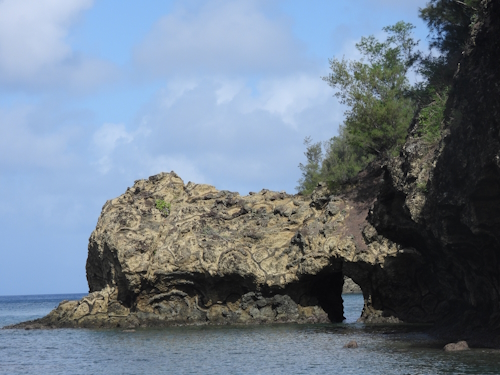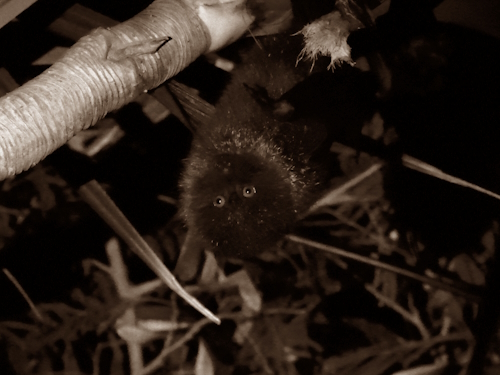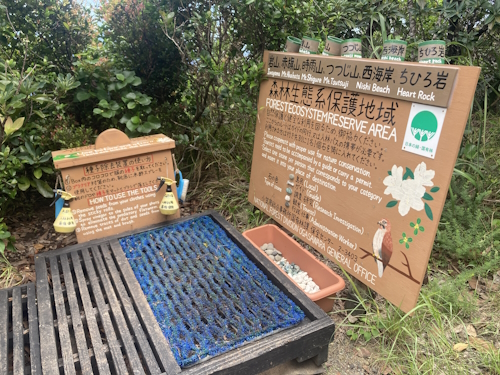Blog WHS Visits
WHS #926: Ogasawara Islands
My first one from the “Takes 5 days or more to visit”-list! The Ogasawara Islands are a Japanese archipelago in the Northern Pacific Ocean about 1,000km south of Tokyo and 1,800km north of Guam. They can only be visited by a weekly ferry which takes 24 hours to cover the distance. About 2,500 people inhabit its two main islands. Settlers arrived here in the 19th century, the islands were mostly uninhabited before. After having been taken by the US during the Second World War, the islands were returned to Japan in 1968.
Despite being a group of islands, the OUV is not marine but firmly focused on land (rapidly diversifying land snails! endemic plants!) – even UNESCO seems to have forgotten that as its Gallery only shows photos of sea creatures. About 80% of the core zones of the 5 components are land-based. On Chichi-jima, where I stayed for 3 nights, the core zone of the WHS covers about 65% of this island; the coastal villages and agricultural fields are excluded.
The protected area that lies closest to the main settlement of Omura is Miyanohama Beach. And that is where I headed on my first afternoon on the island. It’s only a 1.2km walk, but I learned quickly that the hills on the island are very steep. The bay has characteristic volcanic arches and outcrops, and inland I got my first good look at the endemic, fruit-bearing Pandanus trees.
In the evening I joined a Night Tour. My main goal was to see a Bonin Flying Fox, the only endemic mammal of Ogasawara and a nocturnal creature. We started the 2-hour tour at the harbour, where we stared at some eel-like fish. Then we drove to Miyanohama Beach again, where 5 minibusses from other tour companies had already gathered at the parking lot. A long story in Japanese and a lot of anticipation followed (especially by me as I didn’t understand a word), but it turned out that we were to release baby green turtles into the sea! Staff from the Ogasawara Marine Center had brought boxes full of them and gave a box each to the tour leaders. It did feel a bit ambivalent though as green turtle features prominently on the menus of Ogasawara’s restaurants as sushi or in a stew. A licensed fishery is allowed to traditionally capture a limited number of green turtles yearly.
This all took quite a bit of time, so I hoped it wouldn’t hinder my chances of seeing a Flying Fox. We drove to the south of the island (it’s so small that this takes about 15 minutes), stopping at a dark road lined with a series of Pandanus trees. This was the perfect place to look for a Bonin Flying Fox, as the fruits of this tree are its favourites. You could already tell by the mess on the ground that one had been active. It took a bit of searching by the guide (only red lens torches are used), but there it was: hanging upside down, with piercing eyes, and a frizzy hairstyle. Mission completed for me, and a slight revenge for the elusive Shiretoko Brown Bear. We finished the tour with a look at tiny fungi that glow in the dark.
On day two I took the local bus to the last stop, the “southernmost bus stop of Tokyo” (the whole of Ogasawara is a subprefecture of Tokyo). This area called after Kominato Beach is probably the best part of the island to explore on your own. It has a lovely sandy beach surrounded by cliffs showing displays of pillow lava rock created by underwater eruptions (see photo 1), there’s a river walk along the Yatsusegawa which is good for birds and generally scenic. And it’s the starting point for more strenuous hikes. You can walk along the mountain ridges to remote beaches 2 hours away. I only went to Nakajima Pass (20 minutes uphill), which was fully worth it for its stunning coastal views (see main site photo).
Back in the main village of Omura, there is a Visitor Center and a World Heritage Center. Here you can get a better understanding of the unique evolutionary processes that occurred in Ogasawara due to its isolation. It originated from a volcanic eruption, and every species now on it came flying or floating in from different regions. The centers also are probably the only place where you can see snails: the Nomination File is full of them, but in reality, they live mostly on the uninhabited islands and come out only in the wet season. Especially the evolutionary course of the Mandarina land snail is fascinating.
The main part of the national park on Chichi-jima consists of forested mountains. There is a mountain road, but it cannot be accessed by bus and hiking or biking it seems a stretch. Furthermore, several parts of the forest need an official guide to enter. So I chose to do a Forest Hiking Tour with a company called TAKE Nature Academy. As a group of 7, we went to visit 6 different habitats across the island and did a short walk at each of them. We ended up exactly where I had hoped to go. Highlights included Iwayama and Higashidaira Sanctuary. To both specific biosecurity rules apply: there’s a platform at the start of the trail where you have to scrub your shoes to get rid of seeds and spray the soles. There’s also a creative visitor counting system by placing coral rocks into a tube (photo 3).
Iwayama lies in the easternmost part of the island, the volcanic rock is exposed here and there are splendid views along the coast again. The Higashidaira Sanctuary, to protect the endemic Red-headed Wood Pigeon, immediately intrigued me when I saw it on a map during my preparations. This is firmly closed to outsiders, it is even fully fenced – not against tourists but because of feral cats, which have become the biggest threat to native birds. When walking it is common to see traps to catch them as well. I must say that the nature trail here was a bit of a letdown, although we saw some ‘new’ plant species. No bird in sight though!
I loved my stay in Ogasawara and would have happily extended it to 5 days if it were logistically possible – I didn’t do any water-based activities as these aren’t my favourites overall, but you can go whale watching or visit the uninhabited island of Minamijima where they have fossilized snails. Ogasawara combines the good parts of several other island WHS, such as the small-community vibe of Easter Island (the Farewell Ceremony at the ferry’s departure is so moving), the sweeping beaches of Fernando do Noronha, the steep forested slopes of Madeira and the high levels of endemism in plants and animals of the Galapagos Islands. There are lots of practical details to share as well of course as information on Ogasawara in English is scarce – I’ve gathered them all in this Forum post.
Els - 22 September 2024
Comments
Astraftis 23 September 2024
Mine is not a really constructive comment, but: I envy your trip to Ogasawara islands a lot! It is something on my wishlist since eons, but I'll have to postpone it to yet another trip to Japan (by the way, I also had to renounce to Sado).
Thanks for these reports, it is clear you enjoyed it a lot!


